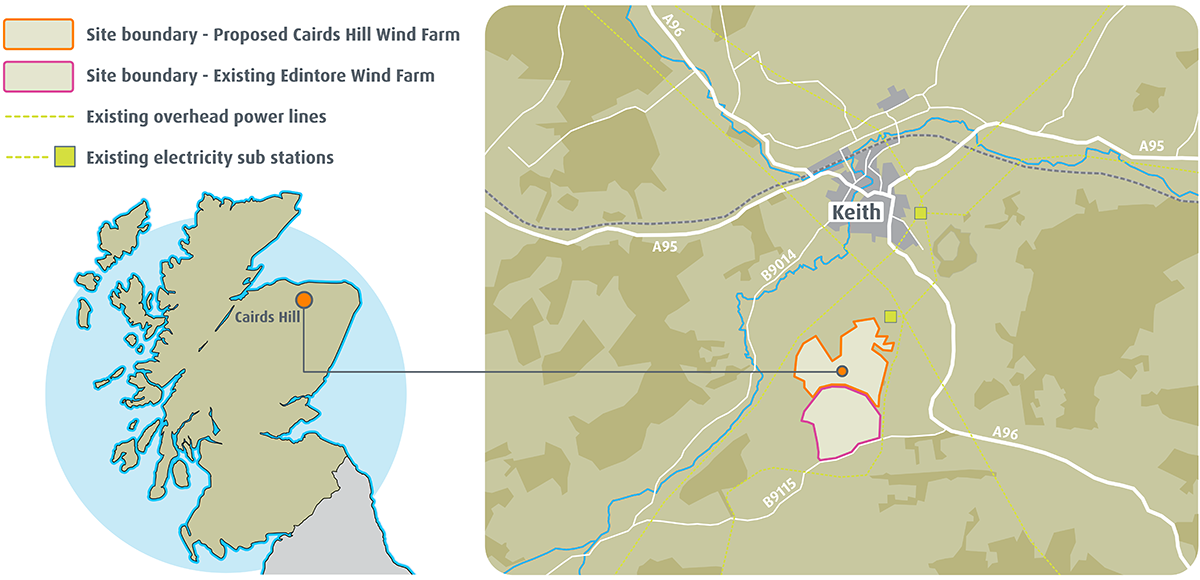Summary
The proposals for the Cairds Hill Wind Farm are for four turbines on the northern edge of the Edintore Wind Farm. The majority of the site is forestry and grazing land adjacent to Blackhillock Substation and Cairds Hill Quarry. The site demonstrates good wind speeds and has been designed as an extension to the existing wind farm.
The proposed Cairds Hill Wind Farm would consist of four turbines with three with a maximum tip height of 180m and one of 150m, and a maximum installed capacity of up to 16.8MW (based on a 4.2MW turbine).
The layout has been informed by a number of technical, environmental, and commercial factors, and been designed as an extension to the existing Edintore Wind Farm. Following commencement and completion of the environmental surveys and feedback from consultees and local communities, the design will be subject to revision.
Details for the application can be viewed on the Moray Council website (24/00617/EIA | Erect four wind turbines three of which are up to 180m to blade tip height and one up to 149.9m blade tip height associated and ancillary infrastructure includes hardstanding areas for each turbine location onsite access tracks an electrical substation and buried cables temporary laydown areas and a temporary construction compound on | Land At Cairds Wood Moray)

Environment
Environmental Impact Assessment
Our team of environmental and technical consultants including landscape architects, ecologists and archaeologists have progressed the studies that will make up the project’s Environmental Impact Assessment (EIA). The information and data from these studies will be used to refine our proposals and also to identify ways in which we could remove, reduce or mitigate any potential impacts.
General Approach
The design and turbine locations as well as other associated infrastructure is an ongoing process informed by the EIA studies and consultation with consultees and the local community. One of our main aims is to create a design that correlates with the existing turbines at Edintore Wind Farm and carefully considers the visual effects on local residential and amenity receptors.
Policy Context
Moray Council was one of the first local authorities in Scotland to declare a ‘climate emergency’ in June 2019 and has set the aim to be carbon neutral by 2030[1].
Additionally, the Scottish Government has declared a ‘climate emergency’ and set a target for Scotland to reduce emissions by 75% by 2030, and to become a ‘net-zero society by 2045’ following advice in May 2019 from the Committee on Climate Change[2].
The UK Government has also set a target of net zero emissions by 2050. The Committee on Climate Change estimates that this would require a quadrupling of electricity generation from low carbon sources such as wind power in order to meet wider government climate change goals such as the electrification of the transport and heat sectors, which will be driven by policies such as the end of the sale of new petrol and diesel cars by 2032 in Scotland[3].
The project could produce up to approximately 55.4 GWh each year[4], equivalent to the annual power needs of approximately 14,900homes[5], dependent on the ultimate design of the wind farm.
Biodiversity Net Gain
EDP Renewables are dedicated to mitigating environmental effects of our projects while maintaining a strong commitment to environmental and biodiversity enhancements.
By striking a balance between responsible development and environmental conservation, we aspire to deliver clean energy and contribute to the preservation and improvements of our surroundings.
Submission Steps
A pre-application meeting was held virtually with Moray Council and other statutory consultees to present the initial proposals for Cairds Hill (originally called Edintore II Wind Farm) and receive initial feedback. We submitted an Environmental Impact Assessment (EIA) Scoping Report to Moray Council in January 2021. Following this, Moray Councils and statutory consultees will respond outlining the environmental information required to be provided within the EIA report as part of the planning application.
After the public exhibition to engage with the local community and receive feedback on our proposals the planning application will be produced. This was submitted to the local authority in April 2024. However, if you do have any questions at this time please do get in touch.
[1] Moray Council aiming to become carbon neutral (Moray Council news release, 2019)
[2] Scotland to become a net zero society (Scottish Government news release, 2019)
[3] Green transport funding pledge (Scottish Government new release, 2018)
[4] Based on average Scottish onshore wind load factor from 2011 to 2018 of 27% detailed in Renewable electricity capacity and generation (ET 6.1)
[5] Based on 2017 average annual consumption per UK household of 3,729kWh as per Sub-National Electricity and Gas Consumption Statistics Regional and Local Authority.

